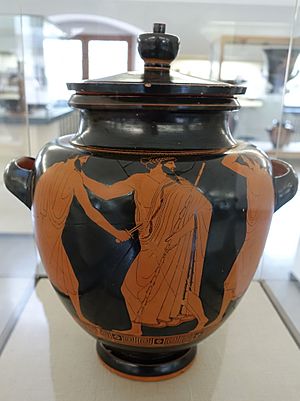Harmodius and Aristogeiton facts for kids
Harmodius and Aristogeiton were two famous Athenians from ancient Greece who lived around 514 BC. They are known as the "Tyrannicides" because they killed Hipparchus, who was the brother of Hippias, the ruler (or tyrant) of Athens. Even though they were executed for this act, their actions helped lead to big changes in Athens. A few years later, in 510 BC, the Spartan king Cleomenes I helped remove Hippias from power. This opened the way for important democratic changes made by Cleisthenes. Later, Athenians celebrated Harmodius and Aristogeiton as national heroes. This also helped hide the fact that Sparta played a role in ending the tyranny in Athens. Cleisthenes even ordered famous statues to be made of them.
Contents
Understanding the Background
We learn about Harmodius and Aristogeiton from old writings. The most important sources are History of the Peloponnesian War by Thucydides and The Constitution of the Athenians, which is thought to be by Aristotle or his students. Many other ancient writers, like Herodotus and Plutarch, also wrote about them.
In ancient Greece, a "tyrant" was someone who took power without following the usual laws of the state. It didn't always mean they were evil. Peisistratus became the tyrant of Athens in 546/7 BC. When he died in 528/7 BC, his son Hippias took over as the new tyrant. His brother, Hipparchus, helped him and was like a minister of culture. They continued their father's way of ruling. However, people started to dislike them because Hipparchus began to misuse his power.
The Assassination Plot
Harmodius and Aristogeiton planned to kill Hipparchus during the Panathenaic Games. This was a big festival in Athens. They chose this day because it was normal for citizens in the procession to carry weapons. Carrying weapons on any other day would have looked suspicious. They hid their daggers in ceremonial myrtle wreaths. Several other people were part of their secret plan.
On the day of the festival, Harmodius and Aristogeiton saw one of their co-conspirators talking in a friendly way with Hippias. They thought they had been betrayed and rushed into action. This ruined their careful plans. They managed to kill Hipparchus as he was getting the Panathenaic processions ready near the Acropolis. Harmodius was killed right away by Hipparchus's guards. Aristogeiton was arrested soon after.
When Hippias found out, he pretended to be calm. He told the marching Greeks to put down their ceremonial weapons and gather in one spot. He then arrested anyone who had hidden weapons or seemed suspicious. This stopped the uprising for a short time.
What Happened Next
His brother's murder made Hippias rule even more strictly. People really disliked this harsh rule. Eventually, in 510 BC, an army from Sparta, led by King Cleomenes I, helped overthrow Hippias. After Hippias was gone, Cleisthenes made many important changes. These changes helped set up a democracy in Athens.
Becoming Athenian Heroes
Over time, Harmodius and Aristogeiton became seen as heroes for Athenian freedom. They were called "the Liberators" and "the Tyrannicides." Later writers said that the families of Harmodius and Aristogeiton were given special rights. These included the right to eat meals at public expense and special seats in the theater. The Athenians promoted their story to make it seem like they removed the tyranny themselves, rather than owing it to Sparta.
Statues and Artworks
After democracy was established, Cleisthenes asked the sculptor Antenor to create a bronze statue group of Harmodius and Aristogeiton. This was a very important moment. It was the first time public money was used to pay for a statue. They were the first Greeks considered worthy of having statues made of them. The statue was likely placed in the Agora, which was the main public space in Athens. Special laws even stopped other statues from being put near theirs. A poem by Simonides was carved on its base:
A marvelous great light shone upon Athens when Aristogeiton and Harmodios slew Hipparchus.
In 480 BC, during the early Greco-Persian Wars, the Persian king Xerxes I took the statue as war treasure. He put it in his city of Susa. As soon as the Greeks defeated the Persians at Salamis, a new statue was ordered. This one was made by Kritios and Nesiotes in 477/476 BC. The statues we see today, found in the ruins of Hadrian's villa, are copies of this second group. Later, when Alexander the Great conquered the Persian empire in 330 BC, he found the original statue in Susa and sent it back to Athens.
Other artists also made statues of these heroes. Their image also appeared on painted vases and in other artworks.
Songs of Praise
Another way people honored Harmodius and Aristogeiton was through a special hymn called a skolion. This song praised them for bringing isonomia (equal justice) back to the Athenians. The song was very popular. People sang it at banquets and even in the streets. When someone sang this song, they would hold a branch of myrtle in their hand.
See also
 In Spanish: Harmodio y Aristogitón para niños
In Spanish: Harmodio y Aristogitón para niños
- Athenian democracy
- Harmodius and Aristogeiton (sculpture)


